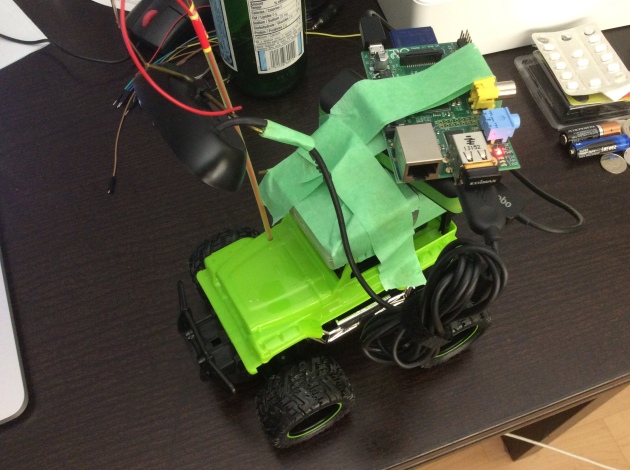|
__author__ = 'zhengwang' |
|
|
|
import numpy as np |
|
import cv2 |
|
import serial |
|
import pygame |
|
from pygame.locals import * |
|
import socket |
|
|
|
|
|
class CollectTrainingData(object): |
|
|
|
def __init__(self): |
|
|
|
self.server_socket = socket.socket() |
|
self.server_socket.bind(('192.168.1.72', 8000)) |
|
self.server_socket.listen(0) |
|
|
|
# accept a single connection |
|
self.connection = self.server_socket.accept()[0].makefile('rb') |
|
|
|
# connect to a seral port |
|
self.ser = serial.Serial('/dev/cu.usbserial-AM01VDMD', 115200, timeout=1) |
|
self.send_inst = True |
|
|
|
# create labels |
|
self.k = np.zeros((4, 4), 'float') |
|
for i in range(4): |
|
self.k[i, i] = 1 |
|
self.temp_label = np.zeros((1, 4), 'float') |
|
|
|
|
|
def collect_image(self): |
|
|
|
saved_frame = 0 |
|
total_frame = 0 |
|
|
|
# collect images for training |
|
print('Start collecting images…') |
|
e1 = cv2.getTickCount() |
|
image_array = np.zeros((1, 38400)) |
|
label_array = np.zeros((1, 4), 'float') |
|
|
|
# stream video frames one by one |
|
try: |
|
stream_bytes = ' ' |
|
frame = 1 |
|
while self.send_inst: |
|
stream_bytes += self.connection.read(1024) |
|
first = stream_bytes.find('\xff\xd8') |
|
last = stream_bytes.find('\xff\xd9') |
|
if first != -1 and last != -1: |
|
jpg = stream_bytes[first:last + 2] |
|
stream_bytes = stream_bytes[last + 2:] |
|
image = cv2.imdecode(np.fromstring(jpg, dtype=np.uint8), cv2.CV_LOAD_IMAGE_GRAYSCALE) |
|
|
|
# select lower half of the image |
|
roi = image[120:240, :] |
|
|
|
# save streamed images |
|
cv2.imwrite('training_images/frame{:>05}.jpg'.format(frame), image) |
|
|
|
#cv2.imshow('roi_image', roi) |
|
cv2.imshow('image', image) |
|
|
|
# reshape the roi image into one row array |
|
temp_array = roi.reshape(1, 38400).astype(np.float32) |
|
|
|
frame += 1 |
|
total_frame += 1 |
|
|
|
# get input from human driver |
|
for event in pygame.event.get(): |
|
if event.type == KEYDOWN: |
|
key_input = pygame.key.get_pressed() |
|
|
|
# complex orders |
|
if key_input[pygame.K_UP] and key_input[pygame.K_RIGHT]: |
|
print("Forward Right") |
|
image_array = np.vstack((image_array, temp_array)) |
|
label_array = np.vstack((label_array, self.k[1])) |
|
saved_frame += 1 |
|
self.ser.write(chr(6)) |
|
|
|
elif key_input[pygame.K_UP] and key_input[pygame.K_LEFT]: |
|
print("Forward Left") |
|
image_array = np.vstack((image_array, temp_array)) |
|
label_array = np.vstack((label_array, self.k[0])) |
|
saved_frame += 1 |
|
self.ser.write(chr(7)) |
|
|
|
elif key_input[pygame.K_DOWN] and key_input[pygame.K_RIGHT]: |
|
print("Reverse Right") |
|
self.ser.write(chr(8)) |
|
|
|
elif key_input[pygame.K_DOWN] and key_input[pygame.K_LEFT]: |
|
print("Reverse Left") |
|
self.ser.write(chr(9)) |
|
|
|
# simple orders |
|
elif key_input[pygame.K_UP]: |
|
print("Forward") |
|
saved_frame += 1 |
|
image_array = np.vstack((image_array, temp_array)) |
|
label_array = np.vstack((label_array, self.k[2])) |
|
self.ser.write(chr(1)) |
|
|
|
elif key_input[pygame.K_DOWN]: |
|
print("Reverse") |
|
saved_frame += 1 |
|
image_array = np.vstack((image_array, temp_array)) |
|
label_array = np.vstack((label_array, self.k[3])) |
|
self.ser.write(chr(2)) |
|
|
|
elif key_input[pygame.K_RIGHT]: |
|
print("Right") |
|
image_array = np.vstack((image_array, temp_array)) |
|
label_array = np.vstack((label_array, self.k[1])) |
|
saved_frame += 1 |
|
self.ser.write(chr(3)) |
|
|
|
elif key_input[pygame.K_LEFT]: |
|
print("Left") |
|
image_array = np.vstack((image_array, temp_array)) |
|
label_array = np.vstack((label_array, self.k[0])) |
|
saved_frame += 1 |
|
self.ser.write(chr(4)) |
|
|
|
elif key_input[pygame.K_x] or key_input[pygame.K_q]: |
|
print 'exit' |
|
self.send_inst = False |
|
self.ser.write(chr(0)) |
|
break |
|
|
|
elif event.type == pygame.KEYUP: |
|
self.ser.write(chr(0)) |
|
|
|
# save training images and labels |
|
print("train") |
|
train = image_array[1:, :] |
|
print("label") |
|
train_labels = label_array[1:, :] |
|
|
|
# save training data as a numpy file |
|
print("np") |
|
np.savez('training_data_temp/test08.npz', train=train, train_labels=train_labels) |
|
|
|
e2 = cv2.getTickCount() |
|
# calculate streaming duration |
|
time0 = (e2 – e1) / cv2.getTickFrequency() |
|
print('Streaming duration:', time0) |
|
|
|
print(train.shape) |
|
print(train_labels.shape) |
|
print('Total frame:', total_frame) |
|
print('Saved frame:', saved_frame) |
|
print('Dropped frame', total_frame – saved_frame) |
|
|
|
finally: |
|
self.connection.close() |
|
self.server_socket.close() |
|
|
|
if __name__ == '__main__': |
|
print("Entering main function") |
|
print("Press q to quit on the video capture pygame area") |
|
print("Initializing pygame") |
|
pygame_init = pygame.init() |
|
print("Initializing Collection of Training Data Object") |
|
ctd = CollectTrainingData() |
|
print("Server Sockets setup") |
|
ctd.collect_image() |
|
|








